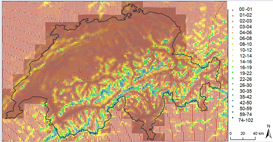Mapping and Forecasting Icing on Structures
 More and more wind energy projects are situated in areas affected by icing, such as Canada, Scandinavia and the Alps. Icing causes a decrease in power output and an increase in risk (e.g. by ice throw). For that reason collecting information about icing conditions is a crucial part of site assessment in many regions of the world. Additionally, icing forecasts are important when operating a wind farm under icing conditions in order to reach optimal performance. Icing itself is difficult to measure and a dense observation network is mostly missing. Numerical weather forecast models have the potential to fill the gap. In this article, a coupled model system consisting of a weather forecast model and an icing algorithm that simulates ice accretion on a cylindrical structure is presented. The system’s ability to simulate icing events is investigated. Additionally, the use of model simulations for mapping icing frequencies is shown. Finally, other information gained from model simulations and future challenges are discussed.
More and more wind energy projects are situated in areas affected by icing, such as Canada, Scandinavia and the Alps. Icing causes a decrease in power output and an increase in risk (e.g. by ice throw). For that reason collecting information about icing conditions is a crucial part of site assessment in many regions of the world. Additionally, icing forecasts are important when operating a wind farm under icing conditions in order to reach optimal performance. Icing itself is difficult to measure and a dense observation network is mostly missing. Numerical weather forecast models have the potential to fill the gap. In this article, a coupled model system consisting of a weather forecast model and an icing algorithm that simulates ice accretion on a cylindrical structure is presented. The system’s ability to simulate icing events is investigated. Additionally, the use of model simulations for mapping icing frequencies is shown. Finally, other information gained from model simulations and future challenges are discussed.
By Silke Dierer and Rene Cattin, Meteotest, Thomas Grünewald and Michael Lehnin, WSL Institute for Snow and Avalanche Research and Philippe Steiner, Federal Office of Meteorology and Climatology, Switzerland
 More and more wind energy projects are situated in areas affected by icing, such as Canada, Scandinavia and the Alps. Icing causes a decrease in power output and an increase in risk (e.g. by ice throw). For that reason collecting information about icing conditions is a crucial part of site assessment in many regions of the world. Additionally, icing forecasts are important when operating a wind farm under icing conditions in order to reach optimal performance. Icing itself is difficult to measure and a dense observation network is mostly missing. Numerical weather forecast models have the potential to fill the gap. In this article, a coupled model system consisting of a weather forecast model and an icing algorithm that simulates ice accretion on a cylindrical structure is presented. The system’s ability to simulate icing events is investigated. Additionally, the use of model simulations for mapping icing frequencies is shown. Finally, other information gained from model simulations and future challenges are discussed.
More and more wind energy projects are situated in areas affected by icing, such as Canada, Scandinavia and the Alps. Icing causes a decrease in power output and an increase in risk (e.g. by ice throw). For that reason collecting information about icing conditions is a crucial part of site assessment in many regions of the world. Additionally, icing forecasts are important when operating a wind farm under icing conditions in order to reach optimal performance. Icing itself is difficult to measure and a dense observation network is mostly missing. Numerical weather forecast models have the potential to fill the gap. In this article, a coupled model system consisting of a weather forecast model and an icing algorithm that simulates ice accretion on a cylindrical structure is presented. The system’s ability to simulate icing events is investigated. Additionally, the use of model simulations for mapping icing frequencies is shown. Finally, other information gained from model simulations and future challenges are discussed.By Silke Dierer and Rene Cattin, Meteotest, Thomas Grünewald and Michael Lehnin, WSL Institute for Snow and Avalanche Research and Philippe Steiner, Federal Office of Meteorology and Climatology, Switzerland










